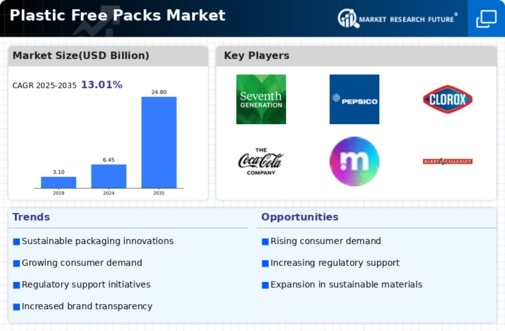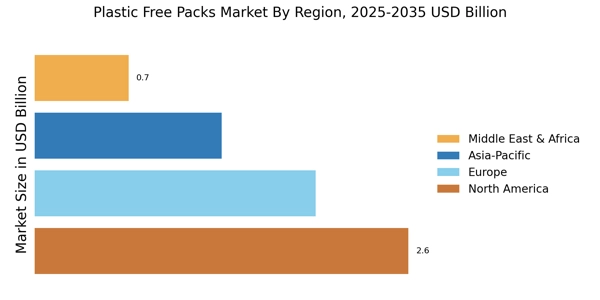Regulatory Frameworks
The establishment of stringent regulatory frameworks is a significant driver for the Plastic Free Packs Market. Governments across various regions are implementing policies aimed at reducing plastic waste and promoting sustainable packaging solutions. These regulations often include bans on single-use plastics and incentives for companies that adopt eco-friendly practices. As a result, businesses are increasingly compelled to transition towards plastic-free alternatives to comply with these regulations. The regulatory landscape is evolving, with many countries setting ambitious targets for reducing plastic consumption. This shift not only encourages innovation in the packaging sector but also creates a favorable environment for the growth of the Plastic Free Packs Market, as companies seek to align their operations with regulatory expectations.
Sustainability Initiatives
The increasing emphasis on sustainability initiatives is a primary driver for the Plastic Free Packs Market. Companies are increasingly adopting eco-friendly practices to align with consumer preferences for sustainable products. This shift is evident as many organizations are committing to reducing their carbon footprints and minimizing plastic waste. According to recent data, the market for sustainable packaging is projected to reach substantial figures, indicating a growing trend towards environmentally responsible packaging solutions. As consumers become more aware of environmental issues, their demand for plastic-free options is likely to rise, compelling manufacturers to innovate and invest in sustainable materials. This trend not only enhances brand loyalty but also positions companies favorably in a competitive market, thereby driving growth in the Plastic Free Packs Market.
Technological Advancements
Technological advancements play a crucial role in shaping the Plastic Free Packs Market. Innovations in material science have led to the development of alternative packaging solutions that are both functional and environmentally friendly. For instance, advancements in plant-based materials and compostable films are gaining traction among manufacturers. These technologies not only reduce reliance on traditional plastics but also offer comparable performance in terms of durability and shelf life. The market is witnessing a surge in research and development activities aimed at creating new biodegradable materials. As these technologies mature, they are expected to lower production costs and enhance the availability of plastic-free options, thus stimulating demand within the Plastic Free Packs Market.
Consumer Awareness and Education
Consumer awareness and education regarding environmental issues are pivotal drivers for the Plastic Free Packs Market. As individuals become more informed about the detrimental effects of plastic pollution, their purchasing decisions are increasingly influenced by sustainability considerations. This heightened awareness is prompting consumers to seek out brands that prioritize eco-friendly packaging solutions. Market Research Future indicates that a significant percentage of consumers are willing to pay a premium for products packaged in sustainable materials. Consequently, companies are responding to this demand by enhancing their product offerings with plastic-free packaging options. This trend not only fosters brand loyalty but also propels the growth of the Plastic Free Packs Market as businesses strive to meet the evolving expectations of environmentally conscious consumers.
Corporate Social Responsibility (CSR)
Corporate Social Responsibility (CSR) initiatives are emerging as a vital driver for the Plastic Free Packs Market. Companies are increasingly recognizing the importance of integrating sustainability into their business models as part of their CSR commitments. This shift is often motivated by the desire to enhance brand reputation and build trust with consumers. Many organizations are setting ambitious sustainability goals, including the elimination of plastic from their packaging. As a result, there is a growing trend of partnerships between businesses and environmental organizations to promote plastic-free alternatives. This collaborative approach not only amplifies the impact of CSR initiatives but also contributes to the overall growth of the Plastic Free Packs Market, as companies strive to demonstrate their commitment to environmental stewardship.


















Leave a Comment